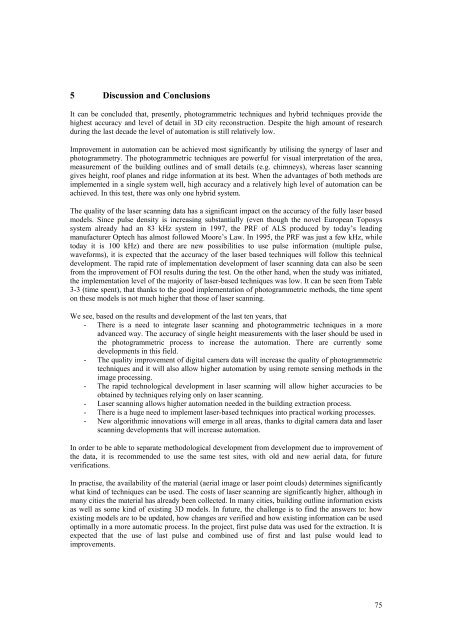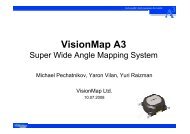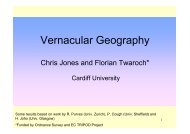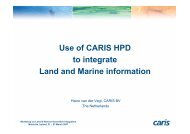EuroSDR Projects - Host Ireland
EuroSDR Projects - Host Ireland
EuroSDR Projects - Host Ireland
Create successful ePaper yourself
Turn your PDF publications into a flip-book with our unique Google optimized e-Paper software.
5 Discussion and Conclusions<br />
It can be concluded that, presently, photogrammetric techniques and hybrid techniques provide the<br />
highest accuracy and level of detail in 3D city reconstruction. Despite the high amount of research<br />
during the last decade the level of automation is still relatively low.<br />
Improvement in automation can be achieved most significantly by utilising the synergy of laser and<br />
photogrammetry. The photogrammetric techniques are powerful for visual interpretation of the area,<br />
measurement of the building outlines and of small details (e.g. chimneys), whereas laser scanning<br />
gives height, roof planes and ridge information at its best. When the advantages of both methods are<br />
implemented in a single system well, high accuracy and a relatively high level of automation can be<br />
achieved. In this test, there was only one hybrid system.<br />
The quality of the laser scanning data has a significant impact on the accuracy of the fully laser based<br />
models. Since pulse density is increasing substantially (even though the novel European Toposys<br />
system already had an 83 kHz system in 1997, the PRF of ALS produced by today’s leading<br />
manufacturer Optech has almost followed Moore’s Law. In 1995, the PRF was just a few kHz, while<br />
today it is 100 kHz) and there are new possibilities to use pulse information (multiple pulse,<br />
waveforms), it is expected that the accuracy of the laser based techniques will follow this technical<br />
development. The rapid rate of implementation development of laser scanning data can also be seen<br />
from the improvement of FOI results during the test. On the other hand, when the study was initiated,<br />
the implementation level of the majority of laser-based techniques was low. It can be seen from Table<br />
3-3 (time spent), that thanks to the good implementation of photogrammetric methods, the time spent<br />
on these models is not much higher that those of laser scanning.<br />
We see, based on the results and development of the last ten years, that<br />
- There is a need to integrate laser scanning and photogrammetric techniques in a more<br />
advanced way. The accuracy of single height measurements with the laser should be used in<br />
the photogrammetric process to increase the automation. There are currently some<br />
developments in this field.<br />
- The quality improvement of digital camera data will increase the quality of photogrammetric<br />
techniques and it will also allow higher automation by using remote sensing methods in the<br />
image processing.<br />
- The rapid technological development in laser scanning will allow higher accuracies to be<br />
obtained by techniques relying only on laser scanning.<br />
- Laser scanning allows higher automation needed in the building extraction process.<br />
- There is a huge need to implement laser-based techniques into practical working processes.<br />
- New algorithmic innovations will emerge in all areas, thanks to digital camera data and laser<br />
scanning developments that will increase automation.<br />
In order to be able to separate methodological development from development due to improvement of<br />
the data, it is recommended to use the same test sites, with old and new aerial data, for future<br />
verifications.<br />
In practise, the availability of the material (aerial image or laser point clouds) determines significantly<br />
what kind of techniques can be used. The costs of laser scanning are significantly higher, although in<br />
many cities the material has already been collected. In many cities, building outline information exists<br />
as well as some kind of existing 3D models. In future, the challenge is to find the answers to: how<br />
existing models are to be updated, how changes are verified and how existing information can be used<br />
optimally in a more automatic process. In the project, first pulse data was used for the extraction. It is<br />
expected that the use of last pulse and combined use of first and last pulse would lead to<br />
improvements.<br />
75









